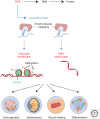Long noncoding RNA: significance and potential in skin biology
- PMID: 24789873
- PMCID: PMC3996376
- DOI: 10.1101/cshperspect.a015404
Long noncoding RNA: significance and potential in skin biology
Abstract
Over the past few years, advances in genome analyses have identified an emerging class of noncoding RNAs that play critical roles in the regulation of gene expression and epigenetic reprogramming. Given their transcriptional pervasiveness, the potential for these intriguing macromolecules to integrate a myriad of external cellular cues with nuclear responses has become increasingly apparent. Recent studies have implicated noncoding RNAs in epidermal development and keratinocyte differentiation, but the complexity of multilevel regulation of transcriptional programs involved in these processes remains ill defined. In this review, we discuss the relevance of noncoding RNA in normal skin development, their involvement in cutaneous malignancies, and their role in the regulation of adult stem-cell maintenance in stratified epithelial tissues. Furthermore, we provide additional examples highlighting the ubiquity of noncoding RNAs in diverse human diseases.
Figures

References
-
- Aravin AA, Sachidanandam R, Girard A, Fejes-Toth K, Hannon GJ 2007. Developmentally regulated piRNA clusters implicate MILI in transposon control. Science 316: 744–747 - PubMed
-
- Bernstein E, Allis CD 2005. RNA meets chromatin. Genes Dev 19: 1635–1655 - PubMed
-
- Bliek J, Terhal P, van den Bogaard M-J, Maas S, Hamel B, Salieb-Beugelaar G, Simon M, Letteboer T, van der Smagt J, Kroes H, et al. 2006. Hypomethylation of the H19 gene causes not only Silver-Russell syndrome (SRS) but also isolated asymmetry or an SRS-like phenotype. Am J Human Genet 78: 604–614 - PMC - PubMed
-
- Bracken AP, Helin K 2009. Polycomb group proteins: Navigators of lineage pathways led astray in cancer. Nat Rev Cancer 9: 773–784 - PubMed
Publication types
MeSH terms
Substances
LinkOut - more resources
Full Text Sources
Other Literature Sources
Medical
Miscellaneous
